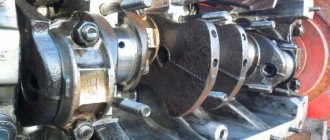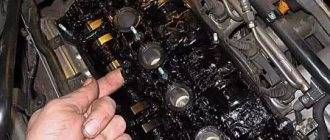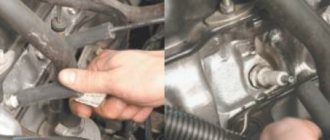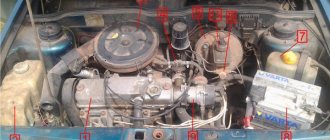Parking up to one month
If there are no malfunctions in your car, then it will always start easily and simply. Often, when parked for up to one month, one problem arises - a discharged battery. In addition, a lot depends on the time of year. In cold weather, being idle for about 10 days always results in the battery running out. In summer, it can only discharge if there is a current leak.
If your battery is dead, use a battery charger or find a machine that can “light” your dead battery.
Also, to start the engine, you will need to use starting clamps, and you also need to know how to “light” the car correctly. It is much easier to start a car with a manual transmission, because you cannot start an automatic with a pushrod.
Parking a car for several months
To first start the engine, you will need to charge the battery. In order to start a car after parking it for several months, you will need:
- Carefully inspect the battery terminals. The formation of oxides at the battery terminals, as well as at the starter contacts, in the connection of the ground wire to the motor, affects long-term engine starting.
- It is imperative to check technical fluids.
If your car was parked in a place where there is high humidity, then oxidation of the distributor terminals or ignition coils is possible. It is necessary to clean the contacts of the distributor if your car’s engine has a contact ignition system.
If you park your car for a long time in the summer, it is possible that all the fuel will dry out. Before starting the car, be sure to pump up the gas. If the engine still does not start, and the whole problem is in the fuel supply, then pour some fuel into the carburetor chamber. Then the engine will definitely start.
Possible faults
A car cannot refuse to start simply on a “whim”; there must be compelling reasons for this. As downtime increases, so does the impact of these negative factors.
Here are some of the main problems:
- battery is low;
- occurrence of rings in the pistons;
- contacts have oxidized;
- air has entered the fuel system;
- Gasoline has evaporated from the carburetor body;
- mice and rats can chew through wiring and hoses, as well as damage other soft parts.
The term “long downtime” is perceived differently by each motorist and therefore starting after different periods should be considered separately.
You will learn about the features of choosing wheel locks in this material.
Here you will also find information on how to properly care for car leather.
Machine downtime no more than one month
If the car was in good working order before it was parked, then there should not be any special difficulties when starting it. Photo: nopoint.ru
The problem is usually a dead battery . You should know that if the car is idle in the winter and the ambient temperature is around -15°C, then it will take 10 to 15 days for the battery to be completely discharged. If the surrounding air is warm, the battery will only lose charge if current leaks.
Signs by which you can recognize a dead battery:
- when you try to start the engine, a characteristic click is heard;
- the starter is slow;
- The indicators on the dashboard do not light up.
There are several simple ways out of this situation. You can charge the battery with a special device or ask for help from other drivers by “lighting” the car from another car. If the gearbox is manual, then you can start it “from the pusher”.
Important! These starting methods are suitable for gasoline engines, but for diesel engines they can cause negative consequences.
Car idle for several months
If the car has been standing motionless for several months, then it is unlikely that you will be able to quickly start the engine. Photo: youtube.com
Before starting, you must:
- Fully charge the car battery.
- Check that coolant and engine oil are present.
- Carefully inspect the starter contacts and battery terminals for the presence of oxide.
Oxidation of terminals and contacts occurs mainly if the car is kept in conditions of high humidity (in a garage with poor ventilation or in the open air).
If the engine has a contact ignition system, then the connecting elements should be cleaned, since when the engine is running, scale forms on them, which, if the car is inactive for a long time, negatively affects starting.
If the “iron friend” is kept in the heat, the fuel in the carburetor may dry out, so before starting the car you need to pump up gasoline using a hand pump, and if this does not help, then you need to pour about 20 grams of fuel into the carburetor.
For a diesel engine, the main reason that the car does not start is the penetration of air into the fuel system. If your car has a device for manual inflation, you should use it. Many machines have special valves for removing air.
Remember! If all actions have not yielded results, then you should check whether the rats have chewed through the wires and hoses.
Starting the engine after “preservation”
If your vehicle sits for a very long time, starting the engine and further maintenance may require special efforts.
You will need to complete the following steps:
- connect a charged battery to check the connection;
- ensure fuel supply. Penetration of moisture or various liquids into the fuel tank is often observed;
- you will need to pour gasoline into the carburetor, a hand pump will help you with this;
- be sure to make sure that there is coolant, also check the engine oil level;
- you will need to normalize the contacts of the distributor, clean them;
- put fresh candles.
We hope that our article was useful to you and you will not have any problems starting your car.
Long-term parking has a negative impact on the mechanisms of a car engine, especially if the car is not prepared for this first. The process of preserving a car implies that all technical fluids are drained from it, and the battery is also removed. If you do not perform these steps before parking the car for a long time, there is a high risk of corrosion in parts, drying out of rubber elements and subsequent problems during operation of the car.
Starting after a long stay in the cold
The tips below only work if the machine is in good working order. In case of problems, you need to follow the instructions given above. So, the procedure for starting the engine after long-term parking at sub-zero temperatures:
- pump up fuel with the accelerator pedal;
- turn on the ignition, wait a few seconds;
- crank the engine after turning on the starter;
- rotate the motor for 10 seconds with breaks of about 2 minutes;
- after starting, warm up the engine to 20 degrees (on cars with manual transmission, everything is done with the clutch depressed; it can only be released at this stage);
- We look for leaks of technical fluids at the bottom of the car.
If the engine is started in very severe frost, then you need to warm it up to minimum temperatures, and then move for some time only at low speeds, avoiding severe overloads. Violation of this rule may lead to engine wedge.
How to prepare a car for starting after a long period of inactivity
There are a few key things to pay attention to after your car has been sitting for a long time. Let's consider each of them separately.
Accumulator battery
The first thing you need to find out is whether the battery was removed from the car before it was idle. If the battery is installed under the hood of your vehicle, it will most likely need to be replaced or charged.
If the terminals were not removed from the battery before the vehicle was parked, the battery is most likely discharged. If the car has been left in this condition for up to a year, you can try to restore the battery by charging it. If the car has been sitting for more than a year, a new battery will most likely be needed.
Checking and replacing technical fluids
The second stage of checking a car that has been sitting idle for a long time is replacing technical fluids. There are quite a lot of them in the car, and before starting you need to make sure that all the fluids are present in the required volume and they have not lost their quality.
Check the following technical fluids:
- Engine oil. Modern motor oil can remain in a car without losing its properties without load for about a year. That is, if the car has been parked for more than 12 months and it is filled with engine oil, it will need to be drained and replaced with new one. When there is no information about how long the car has been parked, you can check the oil visually. If the technical fluid is black, thick and contains contaminants or signs of additive detachment, it must be replaced before starting the engine. Of course, the process of changing engine oil should also be accompanied by replacing the oil filter;
- Fuel in the tank. If the car was not drained of fuel before parking for a long time, this must be done before starting the engine for the first time, and then fill it with new fuel. This is due to the fact that when parked, especially on the street, gasoline and diesel accumulate moisture, which is released. It is strictly not recommended to start the engine with old fuel that has been in the tank for more than six months;
- Brake fluid. Another technical liquid that requires attention due to hygroscopicity, that is, the accumulation of condensate. Typically, brake fluid is changed about once every 24 months. But if the car has been sitting for more than a year, it will need to be replaced. After draining the fluid, bleed the brakes and also check other elements of the brake system for wear: pads, brake discs;
- Coolant. This technical fluid is checked visually. Unscrew the cap of the reservoir where the coolant is filled and inspect it. If “flakes” have formed on the surface of the liquid, it must be drained and replaced with a new one before starting the engine for the first time. If there are no “flakes”, you can try to start the engine with the existing coolant, but then it is important to control the temperature of the engine itself.
Listed above are only the main technical fluids that need to be checked. It is also recommended that before the first start, make sure that there is power steering fluid, that there is oil in the gearbox and other systems where it should be present.
Visual inspection of vehicle parts
Before starting the engine for the first time after a long period of inactivity, it is necessary to visually inspect the vehicle parts. Make sure there are no cracks in the rubber elements, pipes, or hoses of the main components.
How to start the engine after a long period of inactivity
Features of starting the engine after idle time are determined by its duration. Let's look at the most typical cases.
Parking for less than a month
If the car is new or in proper technical condition, there should be no problems starting the power unit. In most cases, the main reason for unsuccessful starts is battery discharge, especially if it happens in winter. In frosts of about 15 degrees, lasting a week or more, a complete discharge of the battery is guaranteed. In summer, such a short parking time should not affect the properties of the battery, although in this case, current leaks are present, but on an insignificant scale.
Symptoms indicating a complete or significant battery discharge:
- if the lights on the dashboard do not light up when the ignition is turned on,
- if an attempt to start the engine is accompanied by a clicking sound, and the starter does not spin,
- when the starter manages to make a few slow revolutions of the crankshaft, after which everything calms down.
In such cases, you should simply charge the battery, and if this is not possible, ask the other driver to “let him light a cigarette” (this procedure requires special starting wires and knowledge in what order to perform it).
If you have a manual transmission, you can try to push start the car - this is one of the most common options. Note that on cars with a diesel power unit, this will require much more effort, and not every such car can be started without consequences using muscle power.
Car idle for several months
In such cases, the algorithm of actions is as follows:
- check the condition of the battery terminals, starter and ground: the presence of oxides significantly reduces the likelihood of a successful start, so such defects must be eliminated,
- We fully charge the battery,
- check the MM and coolant levels,
- if the car was parked in the open, there is a possibility of oxidation of the contacts of the ignition coil and distributor; if this is the case, then they need to be cleaned, including from carbon deposits,
- In carburetor cars, during the warm season, fuel leaves the float chamber and evaporates when idle, so before starting the power unit, pump the fuel pump manually. If this does not help, you can try pouring about 20 grams of gasoline into the float chamber - if the ignition is working properly, this volume is enough for the engine to start,
- For injection cars, such problems are not typical - the main thing is that the fuel return valve is in working order - in this case, the fuel pump will create the necessary pressure for the successful start of the engine,
- on vehicles with a diesel power unit, the fuel system may become airy as a result of prolonged inactivity. You can remove air using a special device for manual pumping, but it is not present on all models. Many diesel cars have a special valve to solve this problem.
If all of the above preparatory operations do not produce results, you should look for a malfunction that does not allow you to start the engine.
Starting the engine of a car that has been preserved
As a rule, such an operation is resorted to if the expected downtime exceeds 1 year. In such cases, starting the engine is always a very responsible procedure, often ending in failure. To minimize the likelihood of such an outcome, you should adhere to the following recommendations:
- charge the battery, connect it, make sure that the terminals are connected securely,
- make sure the fuel system is working properly. Most often, if the car was parked in an open area, moisture gets into the fuel tank. You can get rid of it by draining the old fuel and adding new fuel. There is usually a drain plug in the gas tank for this purpose. In winter, pouring 200-300 g of ethyl alcohol into the tank and then refueling until the tank is full can be quite effective. In this case, alcohol, mixed with water, burns in the cylinders like regular fuel,
- For carburetor cars, fuel is pumped manually using a fuel pump. In diesel power units, a “pear” is used for this,
- A mandatory procedure is checking the level of technical fluids. A deficiency of antifreeze is acceptable - the engine will start, but starting the engine without oil is unacceptable. Topping up should be done with the same lubricant that is present in the engine - mixing oils is unacceptable,
- the next step is to check the condition and clean the contacts of the distributor,
- It is advisable to change the spark plugs with new ones after a very long period of inactivity,
- Another problem, especially when it comes to engines with significant mileage, is coking of the piston rings. You can decarbonize them using several common simple techniques,
- It is also necessary to check the condition of the pipes and pipelines - after such a long period of inactivity, they may crack and lose their tightness.
The nuances of starting the engine in winter after a long period of inactivity
In general, the procedure for preparing a car for start-up is similar to those described above, with the exception of some details. Let us describe the algorithm for this operation:
- pump up the fuel with the accelerator pedal or manually (for carburetor models),
- turn on the ignition and pause for a few seconds,
- turn on the starter for no more than 8-10 seconds; if the attempt is unsuccessful, repeat the operation at two-minute intervals,
- You can make it easier to start the engine in a car with a manual transmission by depressing the clutch pedal. It should be released only after the engine has warmed up (when a stable operating mode has been achieved),
- if the power unit operates jerkily, repeat the procedure from the very beginning,
- after warming up the engine, we inspect the car for leaks - if there are any, the engine is turned off and the leak is eliminated,
- in severe frost, the engine is warmed up at minimum speed, and the start of movement should be carried out without allowing heavy loads.
How to start the engine after a long period of inactivity
After making sure that the car is ready for the first start after a long period of inactivity, you need to do it correctly so as not to damage the engine components. You need to start the engine carefully, if necessary, purging the engine cylinders by pressing the gas pedal and also squeezing the clutch pedal.
When starting for the first time after a long period of parking, you should not turn the starter for more than 10 seconds. If the engine does not start within 10 seconds, pause and then try again.
Long-term parking of the car in winter requires preliminary preparation. This allows you to eliminate difficulties and malfunctions during subsequent startup.
If the preparatory procedures have not been carried out, the question arises - how to start the car after a long period of inactivity in winter.
The space under the hood is inspected to rule out damage and leaks. The battery, fluid level, and tire pressure require attention.
Visual inspection and starting the engine
Immediately before starting the engine, you need to carefully visually check all the parts of the car. You should make sure that there are no cracks or chips on them, and that no traces of any kind of ruptures appear on the rubber elements and pipes. It is also necessary to check the spark plugs and glow plugs before starting and replace if necessary. And after the driver is convinced that the car is ready to start, he can immediately begin its implementation. This must be done smoothly and carefully. If necessary, you can purge the engine cylinders by simply pressing the gas pedal and squeezing the clutch pedal.
This video provides more details about starting a car engine after a long period of inactivity:
Published: July 27, 2020
The need to warm up the car
If the car is left outside in winter, the need for periodic warming up is determined by the duration of inactivity:
- for several weeks, even at low temperatures, no problems arise - just remove the battery in advance and leave it warm;
- longer parking may require starting once every 2-3 months to ensure the engine is in good working order; It is recommended to take care of charging the battery and ensure the car is moving to work on the brake system and other components.
During long breaks in operation, the best solution is conservation, which prevents the development of problems. In other cases, owners often have a question about whether they need to start the car in winter.
Several factors that determine the answer require attention:
- A cold start harms the engine, which is forced to work in harsh conditions. The oil thickens greatly and loses its ability to lubricate and protect the elements. In such conditions, one start wears out the unit as much as 150–200,000 km.
- When the engine warms up, without further movement, other parts lose their functionality - brakes, chassis, clutch.
Therefore, when starting a car, it is recommended to drive it.
If you can't start the car, you can use a jump starter!
How to start a car after a long period of inactivity
As for cars that sit idle in warm garages for 6-12 months, then the battery will require the closest attention. If the battery has not been removed and the terminals are screwed to the battery, then a deep discharge is quite likely. This battery must be removed and charged before starting. You can also use a jump charger to make starting easier or completely replace the battery with a new one if the battery malfunctions.
After starting the engine, it is also necessary to visually inspect the engine compartment for the integrity of the pipes and possible leaks, check the fluid level and tire pressure.
If the car has been standing on the street for a long time: first start
Trying to start a car after a long period of parking outside during the cold season is considered especially harsh conditions. Before starting the engine for the first time after a long period of inactivity in the cold, you need to first prepare the car. Trying to start the engine right away is strictly prohibited!
Let us add that if the car has been standing for about a year, then there is a high probability of “revitalizing” the old battery by charging. A machine sitting idle for 2 years or more means that a new battery will be needed.
Starting the car with a dead battery
If the machine has been standing for a long time, its technical condition is checked before starting. The battery requires attention. You need to pre-charge or install a new drive. If the car is technically sound, other options appear on how to start the car if the battery is dead in winter.
Different methods are used:
- Towing is an effective method for models with manual transmission. With the help of a working car, the car accelerates to 40 km per hour. The clutch is depressed, 2nd gear is engaged, the clutch is released. Usually it starts right the first time.
- Rolling is an equally effective solution when there is no other car to tow. Several people, or a driver from a descent, accelerates a car with a manual transmission to 20 km per hour. Manipulations are performed as during towing.
- Lighting is a common technique that allows you to start a car from the battery of another car. The procedure must be followed.
- Charging and starting devices are an expensive but effective solution that provides a start.
Here you need to pay attention to how to properly start an automatic car in winter if the driver finds himself in a similar situation. Towing and rolling cannot be used, otherwise the automatic transmission will be seriously damaged.
Preparing for winter or parking allows you to avoid problems with the drive.










